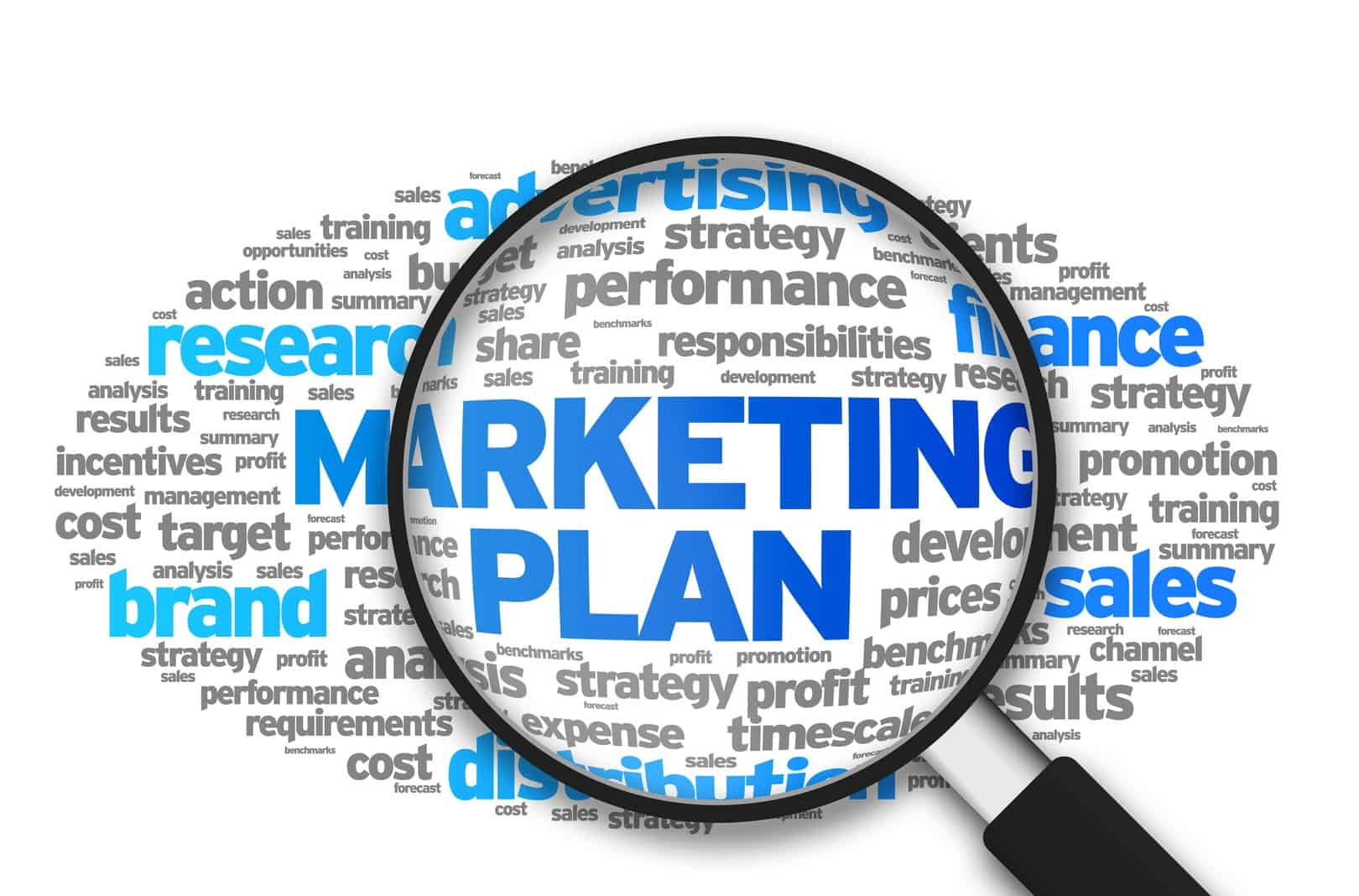ROI of Design: How to Maximize Your Business Strategy?
Many organizations overlook the discipline of design because it’s often not considered important for financial success. However, taking your design strategies seriously might be the missing piece you were looking for to stand out in the market.
According to a McKinsey report, companies that integrate design as a core component of their strategy achieved 32% more revenue and 56% more total return to shareholders than their counterparts.
Thus, we can say that design actions are not merely about aesthetics; they are a crucial element of business strategies that can positively influence a company’s growth. In this context, it’s essential to measure the quality of these design initiatives and their respective return on investment (better known as ROI of Design).
Today, you’ll learn about:
- What is ROI in Graphic Design?
- How to Calculate the ROI of Design?
- What is considered a Good ROI in Business?
- The Impact of Outsourcing on Your ROI of Design (+ Success Story!)
- Final Conclusions about the ROI of Design
Let’s dive into the essentials first!
What is ROI in Graphic Design?
The Return on Investment (ROI) of Design are all the benefits derived from the design strategies applied to your business.
These benefits can be measured using various indicators, which vary depending on your business sector (they can even vary depending on the type of design project).
Here are a few examples of how Design ROI can be measured based on its impact on:
- Reducing your website’s bounce rate
- Increasing qualified leads
- Boosting your sales rate
- Enhancing User Experience (UX)
- Strengthening your brand identity
- Increasing the perceived value of your product or service
- Improving long-term customer satisfaction
- Improving employee motivation in their daily work routine (learn more in our latest study!)
By understanding and measuring the Design ROI in your operations, you can determine which design actions are most beneficial for your business. Additionally, by properly tracking the evolution of this ROI over time, you can optimize your creative strategies and maximize the return on investment.
Remember, in the corporate world, if something isn’t measured, it doesn’t exist! Don’t get left behind, and discover how to calculate the ROI of Design for your company in the next section.

How to Calculate the ROI of Design?
Calculating Design ROI can be challenging due to the mix of qualitative and quantitative factors involved. The complexity also varies depending on each company’s methodology and the unique characteristics of each design project.
However, here are some insights that will help you calculate Design ROI as realistically as possible:
- Identify Your Design Goals: Start by defining the specific goals of your design initiatives. These may include improving website usability, increasing newsletter subscriptions, and improving brand perception, among others. Setting clear objectives provides a solid foundation for you to measure the impact of design in financial terms.
- Determine the Costs: Calculate the total costs associated with your design efforts. This includes designer salaries, software and tool expenses, and any other related costs. If you outsource the service, this calculation will be easier. We recommend being thorough in this part in order to obtain a more accurate ROI of Design.
- Measure the Benefits: In the ROI formula, the "benefits" of design are also known as revenue or income. These can include direct financial gains, such as increased revenue or cost savings, as well as indirect benefits, like improved website usability or long-term increases in customer satisfaction.
- Calculate the ROI: Use the standard ROI formula (see image) to determine the return on your design investment. This formula provides a percentage that indicates the return you get for every dollar spent on your design actions.
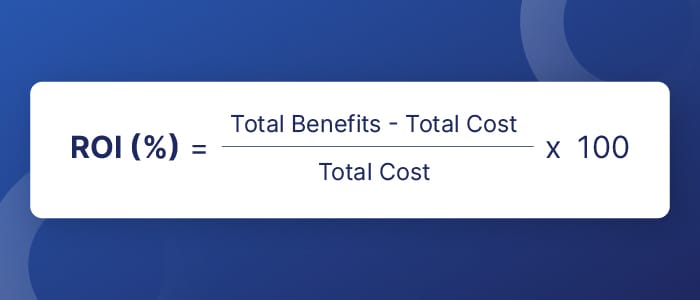
How to Measure the Benefits of a Design Project?
Due to the subjective nature of design, measuring the benefits of your design actions can often be a complex task. You’ll need to collect data and potentially establish a baseline to compare the results of your investments.
That being said, we want to detail some of the most important metrics for measuring the benefits of your creative projects:
Quantitative Metrics and KPIs
When applying the ROI formula, quantitative metrics can be directly added as financial benefits. For example, if the new design generates a $20,000 increase in sales, that amount is incorporated as part of the benefits.
Let’s start with the most common quantitative metrics in marketing and business:
- Increase in Sales: Additional sales value generated after implementing your design action. It’s crucial to compare the results with the previous period to determine the growth margin.
- Increase in Conversion Rate: The percentage of visitors who complete a desired action after the new design is implemented. For example, a new subscription to the newsletter.
- Increase in Web Traffic: The rise in the number of website visits after redesigning the interface or promotional graphic material.
- Repeat Purchase Rate: The increase in the frequency with which customers make repeat purchases after the redesign.
- Increase in Customer Retention Rate: The percentage of customers who remain loyal to your brand after the design update, compared to previous periods.
- Increase in Customer Lifetime Value (CLV): The total value generated by a customer over the course of their relationship with the company. This composite metric includes the average purchase amount, purchase frequency, and the duration of the business relationship.
- Reduction in Customer Acquisition Cost (CAC): The decrease in the average cost to acquire a new customer thanks to the positive impact of the new design on marketing campaigns.
- Reduction in Sales Cycle Time: The decrease in the average time it takes to close a sale due to improvements in the clarity and effectiveness of your design assets. This can include sales presentations or new visuals for your e-commerce.
- Reduction of Operational Costs: Includes savings from more efficient operations, such as reduced production costs, lower overhead, or fewer resources needed.
Qualitative Metrics and KPIs
Although they cannot be directly added in monetary terms, qualitative data can be converted into indirect financial estimates.
Let’s say you find an improvement in User Experience (UX) after a redesign, you can assess its impact by measuring its correlation with metrics like Customer Lifetime Value (CLV) or web conversion rates.
Here are some qualitative metrics you should consider when calculating your ROI of Design:
- Customer Satisfaction Score (CSAT): The percentage of customer satisfaction regarding your products, services, or any specific action. It’s based on the direct question: “On a scale of 1 to 5, how satisfied are you with [product/service/interaction]?”
- Net Promoter Score (NPS): Measures customer loyalty and their willingness to recommend your company, product, or service to others. It’s based on the question: “On a scale of 0 to 10, how likely are you to recommend [product/service/company] to a friend or colleague?”
- Improvements in User Experience (UX): This includes qualitative feedback or scores that indicate enhancements in the ease of use and interaction with your product. Focus on how the design changes have positively impacted user satisfaction and influenced their purchasing decisions.
- Improvement in Brand Perception: Collect insights on how your customers perceive your brand, including their perceptions of product or service quality. Keep in mind that their perceptions affect their willingness to pay and their overall loyalty to your brand.
The most common tool for collecting this qualitative data is through surveys. If you want to make comparisons throughout the time, you need to take different surveys for each period.
Understanding how to measure the ROI of Design provides a more accurate basis for justifying your investments. If you haven’t already, it’s time for you to determine which KPIs should be your top priority!
What is considered a Good ROI in Business?
Determining what constitutes a good ROI in business can vary depending on the industry, company size, and your specific goals.
Unsure if your ROI is on target? Evaluate these factors to see if your design investments are going in the right direction:
- Positive ROI: At a minimum, a good ROI should be positive, meaning that the benefits outweigh the costs. A positive ROI indicates that your design investments are generating value for your business.
- Percentage Returns: A common benchmark for a good ROI is a return of 10% or more. However, some design initiatives can yield much higher returns, especially if they lead to significant improvements in user experience and customer satisfaction.
- Industry Standards: Research the Design ROI standards in your business sector in order to have a reference point for evaluating your performance.
- Long-term Qualitative Impact: In addition to quantitative measures, consider the qualitative impact of design. A better user experience, improved brand perception, and long-term customer retention are valuable outcomes resulting from a good Design ROI.
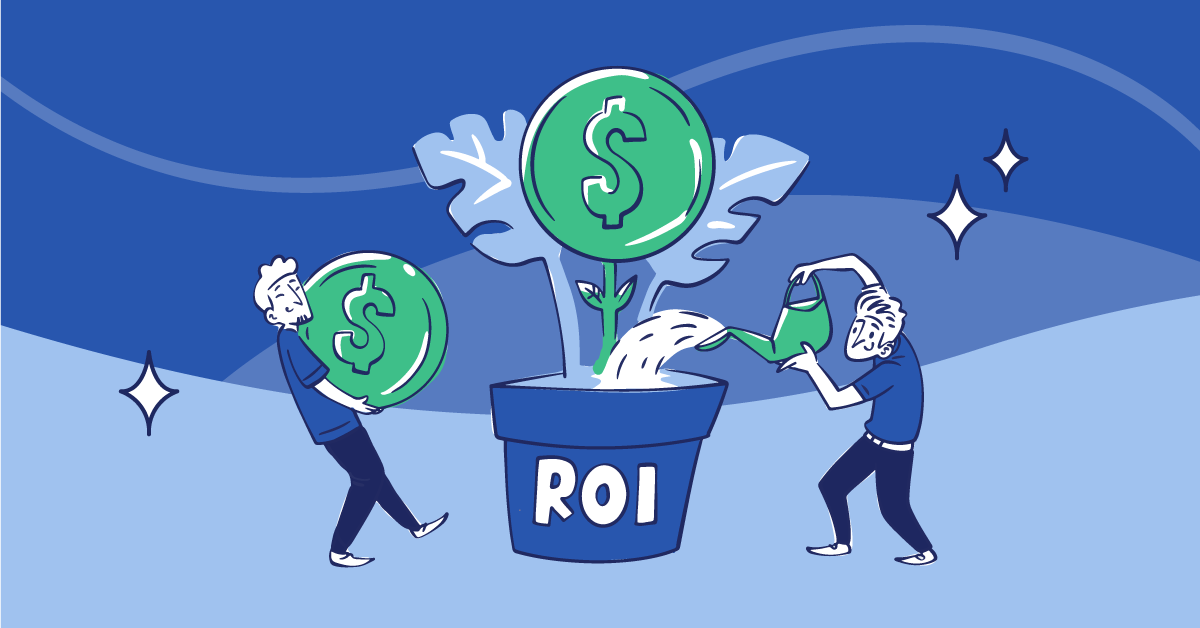
The Impact of Outsourcing on Your ROI of Design
Outsourcing creative tasks can also significantly impact your final Design ROI. By trusting in external expertise, companies can achieve exceptional designs while managing costs effectively.
The biggest challenge lies in aligning the external team (agency, studio, or freelancer) with the internal team’s processes and standards. In this context, effective communication is key to ensuring a successful collaboration.
At 24Slides, we believe that when measuring the ROI of Design, you need to have an open mind and see the whole picture. According to our latest survey, 55% of the specialists say that creating slides is a really time-consuming task and generates demotivation at work.
"We often witnessed how being asked to redo a presentation could cause stress and demotivation. And with little time and extraordinary expectations, the end result is usually not satisfying for any parties involved."
-Marketing Manager interviewed for our latest study
At this point, we can say that delivering design tasks is not for everybody. And with good reason! Every employee is proficient in their area of expertise, and breaking that rule not only creates inefficiency but can also demotivate your team.
Time is a valuable resource, and at 24Slides, we understand that. Let’s see how we can improve this scenario for companies and specialists at all levels:
"Outsourcing design services can significantly impact your ROI in two key ways. First, it saves valuable time for your in-house team, allowing them to focus on strategic tasks rather than creating presentations. Second, with 24Slides, you have predictable costs. Unlike traditional agencies where prices fluctuate during peak seasons, 24Slides maintains steady rates, ensuring a solid ROI without the headache of constant price negotiations."
-Dan Sørensen, Chief Marketing Officer at 24Slides
Success Story: Healthcare Company Optimizes 9,000 Work Hours by Collaborating with 24Slides
At 24Slides, we’re committed to delivering exceptional design, which is why we collaborate with leading companies worldwide. From investor pitch decks to high-impact presentations for various departments and marketing collateral after a brand refresh or rebranding, we handle it all!
With over 200 expert designers, we tailor our services to meet the unique needs of every client, whether you’re a local business or a multinational corporation with a global presence.
In 2023, a global leader in healthcare entrusted us with a large volume of their presentation design workload. We embraced the challenge with great enthusiasm!
A bit of a spoiler for what’s next: this collaboration delivered outstanding results, optimizing over 9,000 hours of our client’s work time and achieving an impressive Design ROI of 176%.
Calculating the ROI of Design
As a practical exercise, let’s calculate the Design ROI of this collaboration. First, it’s important to highlight some data collected in 2023:
- Total hours saved by the client with 24Slides’ partnership = 9,006 hours
- Salary per hour of the client’s employees = $63
- 24Slides’ Service = $205,705
- Total Benefits = Total hours saved by the client x Salary per hour
- Total Cost = 24Slides’ Service
Now, it’s time to refresh the ROI formula:
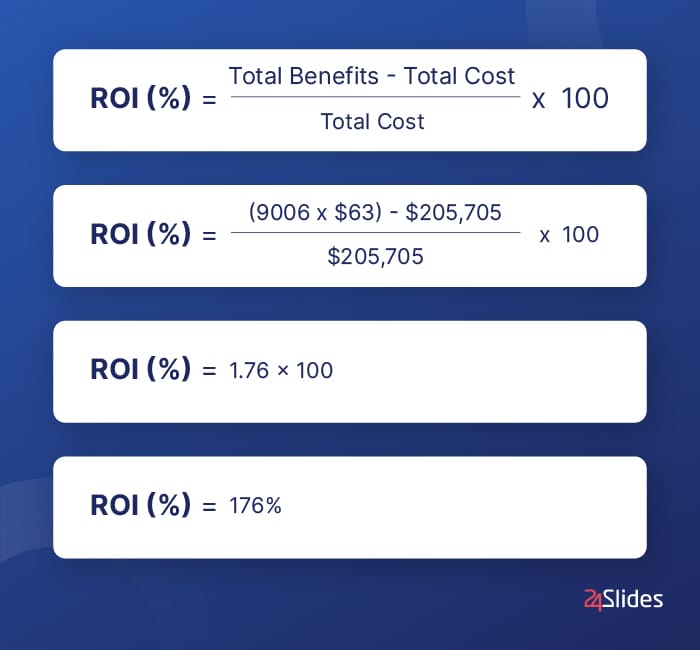
By applying the previous data to the formula, we achieved a Design ROI of 176%, which means that for every dollar invested, our client earned $1.76 in return. This is an excellent result, considering that a 10% ROI is the minimum acceptable for business.
While ROI is typically quantified with hard data, we’ve seen firsthand how design can create powerful effects beyond the numbers. Let’s see some of them for this case study:
- +9,000 hours saved, time redirected to core business activities
- +1,400 presentations designed, enhancing the client’s brand image
- 24-hour turnaround, boosting the client’s workflow
- Increased stakeholder satisfaction with presentation performance
- Improved employee motivation and satisfaction in their daily work routine
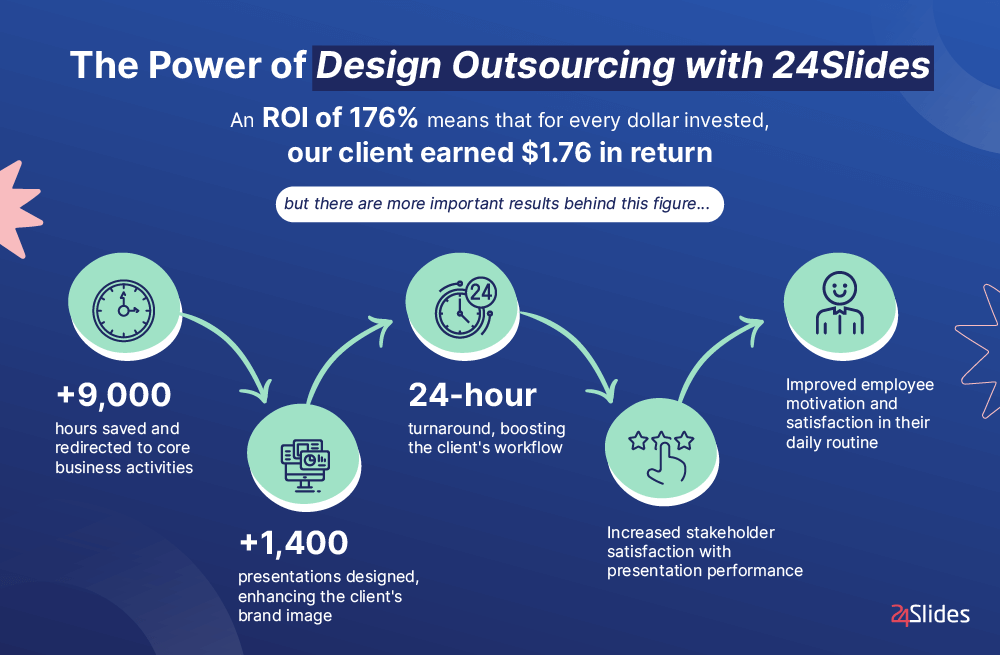
Final Conclusions about the ROI of Design
As design continues to play a crucial role in business growth, mastering the art of measuring ROI becomes increasingly important for small, medium, and large enterprises.
Here are some final thoughts:
- Adopt a Holistic Approach: Understanding and achieving a good Design ROI requires a holistic approach. By considering both quantitative and qualitative benefits, you can better justify your design investments and make more strategic decisions.
- Know Your Business: You can’t measure what you don’t know. While the general ROI formula seems simple, accurate measurement depends on knowing which metrics and KPIs apply to your specific situation. Understand your audience and set profit-driven objectives to achieve better results.
- Design Beyond Aesthetics: The role of design goes beyond a pretty illustration for social media; it can positively impact your marketing actions and the development of your product or service. Taking an integrated approach will enhance the user experience you deliver, which is a powerful differentiator in the market!
- Specialization Matters: Outsourcing your design tasks not only saves valuable time for your employees but also ensures higher product quality, shorter delivery times, and, most importantly, greater motivation for your team, who can focus on their primary tasks.
For a more accurate calculation of the costs your team incurs designing in PowerPoint, check out our hidden cost calculator to find your Design ROI with no problems!
Ready to unlock the full potential of our outsourcing model? Let our team be your creative partner, transforming your ideas into reality and driving your business to success.
Start the journey by booking a call or experiencing our Pro Plan yourself.
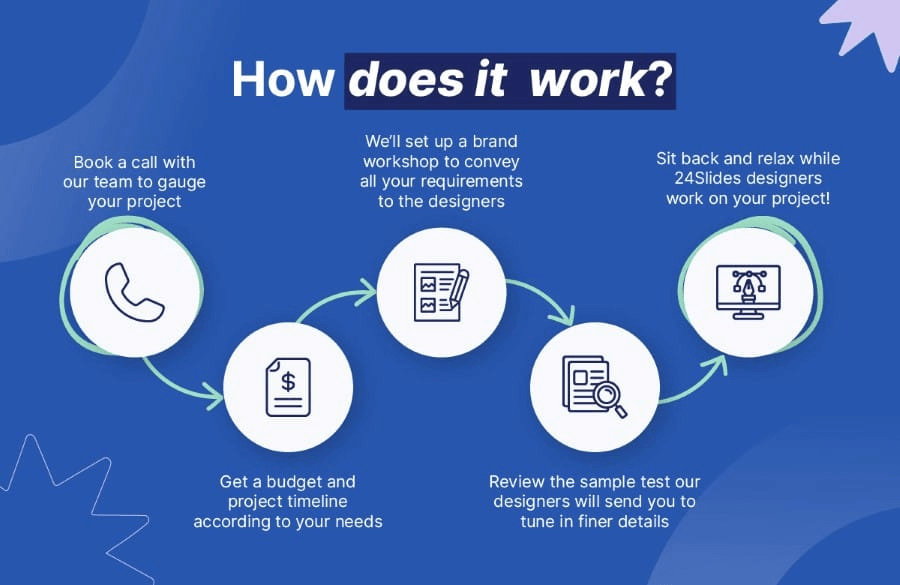
If you enjoy this article, you will love this content:



